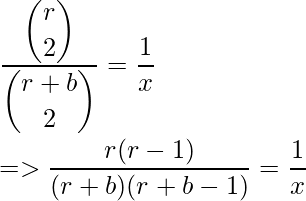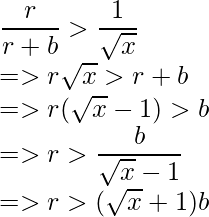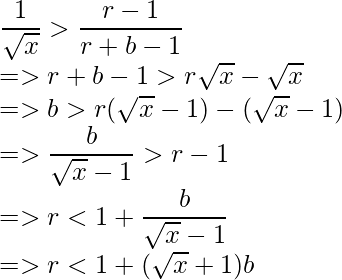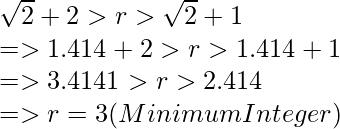Dado un valor X , la tarea es encontrar una string binaria de tamaño mínimo, de modo que si se eliminan 2 caracteres al azar, la probabilidad de que ambos caracteres sean ‘1’ es 1/X . Imprime el tamaño de dicha string binaria.
Ejemplo:
Entrada: X = 2
Salida: 4
Explicación:
Sea la string binaria “0111”.
La probabilidad de elegir 2 1 de la string dada es = 3C2 / 4C2 = 3/6 = 1/2 (que es igual a 1/X).
Por lo tanto, el tamaño requerido es 4.
(Para este ejemplo, se puede tomar cualquier string binaria de 4 tamaños con 3 ‘1’ y 1 ‘0’).
Entrada: X = 8
Salida: 5
Planteamiento: Intentaremos encontrar una fórmula para resolver este problema.
Sea
r = número de 1 en la string
y
b = número de 0 en la string.
- Si se eliminan dos caracteres al azar, entonces
Número total de vías = (r + b) C 2.
- Si se desea que 2 caracteres sean 1, Número favorable de casos = r C 2 .
- Por lo tanto, P(ambos son 1) = r C2 / (r + b) C2 .

- Una observación engañosa para seguir adelante con nuestro cálculo es:

- Elevando al cuadrado la desigualdad y comparando con la igualdad, obtenemos

- Si r > 1, sacamos raíz cuadrada en los 3 lados.

- Tomando la parte más a la izquierda de la desigualdad, obtenemos:

- De manera similar, tomando la parte más a la derecha de la desigualdad, obtenemos:

- Combinando las conclusiones derivadas, obtenemos el rango de r en términos de b.

- Para el valor mínimo de string, establecemos b = 1

- Para obtener un r mínimo válido, tomamos el primer valor entero de r en este rango.
Por ejemplo: si X = 2
Por lo tanto, r = 3 yb = 1 .
P(ambos caracteres son 1) = 3C2 / 4C2 = 2/4 = 1/2
A continuación se muestra la implementación del enfoque anterior.
C++
// C++ implementation of the
// above approach
#include <bits/stdc++.h>
using namespace std;
// Function returns the minimum
// size of the string
int MinimumString(int x)
{
// From formula
int b = 1;
// Left limit of r
double left_lim = sqrt(x) + 1.0;
// Right limit of r
double right_lim = sqrt(x) + 2.0;
int r;
for (int i = left_lim; i <= right_lim; i++) {
if (i > left_lim and i < right_lim) {
// Smallest integer in
// the valid range
r = i;
break;
}
}
return b + r;
}
// Driver Code
int main()
{
int X = 2;
cout << MinimumString(X);
return 0;
}
Java
// Java implementation of the
// above approach
import java.util.*;
class GFG{
// Function returns the minimum
// size of the String
static int MinimumString(int x)
{
// From formula
int b = 1;
// Left limit of r
double left_lim = Math.sqrt(x) + 1.0;
// Right limit of r
double right_lim = Math.sqrt(x) + 2.0;
int r = 0;
for(int i = (int)left_lim; i <= right_lim; i++)
{
if (i > left_lim && i < right_lim)
{
// Smallest integer in
// the valid range
r = i;
break;
}
}
return b + r;
}
// Driver Code
public static void main(String[] args)
{
int X = 2;
System.out.print(MinimumString(X));
}
}
// This code is contributed by PrinciRaj1992
Python3
# Python3 implementation of # the above approach from math import sqrt # Function returns the minimum # size of the string def MinimumString(x): # From formula b = 1 # Left limit of r left_lim = sqrt(x) + 1.0 # Right limit of r right_lim = sqrt(x) + 2.0 for i in range(int(left_lim), int(right_lim) + 1): if(i > left_lim and i < right_lim): # Smallest integer in # the valid range r = i break return b + r # Driver Code if __name__ == '__main__': X = 2 print(MinimumString(X)) # This code is contributed by Shivam Singh
C#
// C# implementation of the
// above approach
using System;
class GFG{
// Function returns the minimum
// size of the String
static int MinimumString(int x)
{
// From formula
int b = 1;
// Left limit of r
double left_lim = Math.Sqrt(x) + 1.0;
// Right limit of r
double right_lim = Math.Sqrt(x) + 2.0;
int r = 0;
for(int i = (int)left_lim; i <= right_lim; i++)
{
if (i > left_lim && i < right_lim)
{
// Smallest integer in
// the valid range
r = i;
break;
}
}
return b + r;
}
// Driver Code
public static void Main(String[] args)
{
int X = 2;
Console.Write(MinimumString(X));
}
}
// This code is contributed by gauravrajput1
Javascript
<script>
// Javascript program for
// the above approach
// Function returns the minimum
// size of the String
function MinimumString(x)
{
// From formula
let b = 1;
// Left limit of r
let left_lim = Math.sqrt(x) + 1.0;
// Right limit of r
let right_lim = Math.sqrt(x) + 2.0;
let r = 0;
for(let i = Math.floor(left_lim); i <= Math.floor(right_lim); i++)
{
if (i > left_lim && i < right_lim)
{
// Smallest integer in
// the valid range
r = i;
break;
}
}
return b + r;
}
// Driver Code
let X = 2;
document.write(MinimumString(X));
</script>
4
Complejidad Temporal: O(1), ya que la diferencia entre el límite izquierdo y el límite derecho será siempre menor que 1.
Espacio Auxiliar: O(1)
Publicación traducida automáticamente
Artículo escrito por greenindia y traducido por Barcelona Geeks. The original can be accessed here. Licence: CCBY-SA
